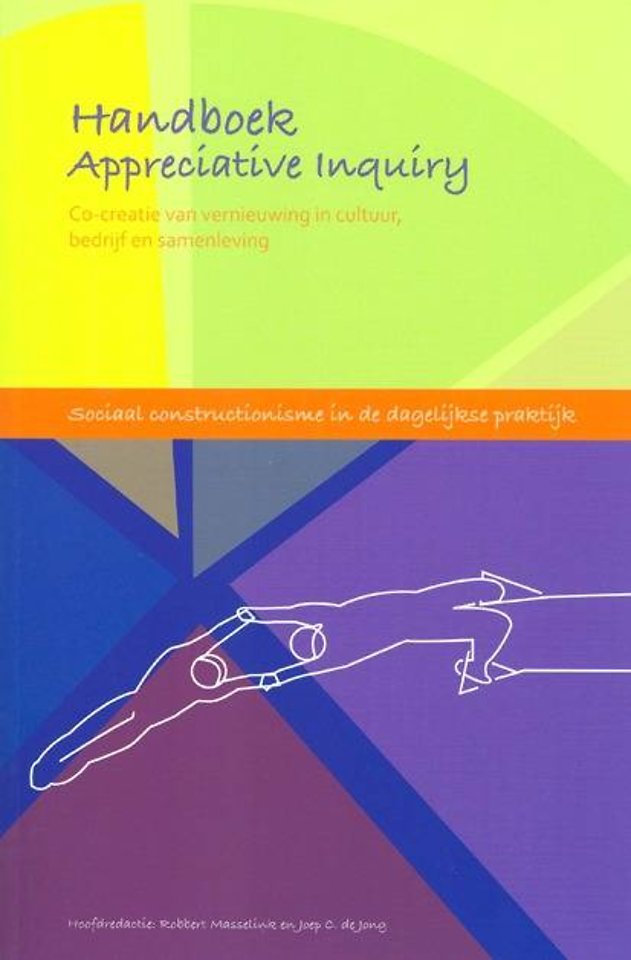
Appreciative inquiry (see Cooperrider et.al. 2011) is an organizational development and change approach, as well as a methodology. Moreover, AI can be considered a philosophy, a worldview.
What AI literally means: to appreciate = to value and recognize the strength of something. To inquire = try to discover and understand it. AI means looking for the best in people and organizations, and finding the strengths that really give life to the organization when it is at its best.
One of the principles of AI is that human systems move in the directions of the questions that they ask. The whole process of asking positive questions will make people engaged and start thinking about those questions. This will create energy and shift in that direction. This means that one of the principals of AI is the process of AI itself: talking about the questions is change in itself. As such, AI is social constructionism in its true form.
Another principle of AI is that of simultaneity: inquiry and change happen simultaneously. This makes it, in fact, design research. Thirdly, since preferably the whole system is engaged in the process, AI is co-creation.
AI may take different forms, but usually involves a process consisting of four steps: Discovery (inquiring after the best of what is in the organization), Dream (of what would be the ideal situation), Design (creating what should be the ideal situation), and Destiny (concrete planning of the realization process). See below for an illustration of the 4D process.
It is crucial to prepare for the AI process by choosing one or more affirmative topics as these will be referred to in the questions underlying the Discovery process. The affirmative topics will also serve as inspiration for the Dream phase and will hence cascade into the Design and Destiny phase. Identifying problems or issues in an organization may be easy but it is essential to turn/reframe the problem(s) into a more positive approach to make sure that everyone who is involved in the AI process will focus on positive topics rather than problems. After having reframed the problem(s) into affirmative topics, positive interview questions should be formulated to identify the strengths that can be built upon.
After this, the actual 4D-process starts with interviewing employees, customers, partners etc., which is usually carried out through either face-to-face interviews or focus group interviews. Ideally, an interview guide is created which usually has a kind of positive preface and then a description of the questions that tie to this positive preface. All interviews may be done by the same interviewer or alternatively the interviewer may interview several people and then give them the interview guide so they can interview others (snowballing). Every time an interview is carried out, someone will be engaged in the questions. Ideally the whole system is involved in all 4 D’s.
Of course, even though the interviewing process is the change methodology in itself, a lot of valuable information comes out of the stories which are captured in the interviews. These stories can be used to identify the themes within the stories, which are the strengths and examples of the principles that are at play within those stories. These can then be used for design and realizing the desired situation.
AI does not have a very solid methodology behind it for the third and fourth D: Design and Destiny. As a result – in some cases – the translation of the outcomes of Discovery and Dream into something that is much more practical (Design and Destiny) may depend on just a few people within the organization. The framework, the methodology is much more dependent on the people doing it. This may be considered a drawback of AI.
In addition to the approach described above, there is the approach called AI Summit which is a completely separate large-scale change methodology. There is some similarity with the World Café method: in an AI summit there are a lot of people in the room who go through a process of people sharing stories and going through the 4D-process. When they get to the D for Design, there are typically a lot of different areas around the room for different topics, so people can go to those areas that they are interested in themselves. The basic principal of one or more affirmative topics and positive interview questions are maintained, naturally.
Because it is a philosophy/worldview and because it has some methodologies in it, AI can be used in a wide range of situations: within organisations, focused on (or together with) customers, and for B2B as well as B2C organisations. In addition, depending on how you apply it, the topic can be anything. Topics can range from efficiency within organizations, internal collaboration, to new product development.
Text: Estelle Nieuwenkamp 2013
 Appreciative inquiry : waarderende werkvormen voor trainers, teamcoaches en veranderaars by Matthijs Steeneveld
Appreciative inquiry : waarderende werkvormen voor trainers, teamcoaches en veranderaars by Matthijs Steeneveld Handboek appreciative inquiry : co-creatie van vernieuwing in cultuur, bedrijf en samenleving by onder redactie van Robbert Masselink, Joep C. de Jong
Handboek appreciative inquiry : co-creatie van vernieuwing in cultuur, bedrijf en samenleving by onder redactie van Robbert Masselink, Joep C. de Jong Waarderend veranderen : Appreciative Inquiry in de dagelijkse praktijk van managers by Tjepkema, S. (Saskia)
Waarderend veranderen : Appreciative Inquiry in de dagelijkse praktijk van managers by Tjepkema, S. (Saskia) AI practitioner : international journal of appreciative inquiry
AI practitioner : international journal of appreciative inquiry